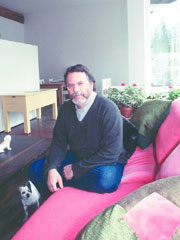Name: Roy McMakin
Occupation: Artist/furniture designer
Neighborhood: Madrona
Why do you live here?
I ended up here because I wanted to be able to have my own shop and production [facility], and I didn’t feel like Southern California was a good place to do that because there wasn’t a real craft ethos.
How long have you lived here?
I’ve been here about three years, [and] in the neighborhood since ’93.
How did you find this place?
I ended up in this neighborhood because I wanted to restore an Ellsworth Storey house that happened to be here, and I liked [Madrona] a lot, and I was sick of living in an antique. I wanted to live in a less specific space that had more sense of flexibility.
To what extent does this space reflect you, your personality, your tastes?
It was built in the ’30s as a Safeway store. There was a personality which I’ve enjoyed enhancing and playing off of. It was sort of an editing and a clarification and a dialogue with something existing.
What would you say your “style” is, as shown by how you put your place together?
I never went to school for design or architecture. So a lot of my education, so to speak, came from knowing architecture, which came from restoring it and understanding it and living in it. I saw what architecture was about, which is essentially about an object that . . . orchestrates life and movement and has meaning—not so much how it just sits there as an interesting object, but how it affects the daily pattern of your life.
I think my education very much has been getting to know very, very intimately things that I see. The Ellsworth Storey [house] was a profound and really important part of my education. But, you know, you graduate.
I knew I needed something that I had a stronger hand in. Even though I didn’t build this building, it’s essentially a piece of architecture that I created in choices and decisions. That was important to me. This space is very neutral. It’s not rooms.
What do you value most about this space?
The [old Storey] house . . . felt like when it was done it was done: There it was—this perfect thing. But with this, there’s a lot of stuff I can bring in, and stuff moves through here. You might bring in an object or piece of furniture that’s here for a while, and I know that eventually there’ll be something else. Eventually I might add on to the roof, a second story, or I might do this . . . there’s always plans. I don’t think this building will ever be done. It’ll always be a work-in-progress, and that was very much what I wanted in my life.
The idea of living in a classic loft space is great. It’s really fun. It’s fun to have everything together. I like that my bed is 10 feet from my desk in my office.
What are the benefits to living in this area/neighborhood?
I like that I have the nicest loft in Madrona. [Laughs.] It is a rare and neat thing to live in what is essentially an older, in-city residential neighborhood with trees and stuff but yet have a more urban thing. I much prefer this over being downtown.
I’m really fortunate that I found this spot. Because it is, essentially, a block and one-half of commercial in what’s become one of the most desirable residential areas.
What is your favorite feature inside your home?
There’s nothing fixed about it. I got it to this place, but I also feel if in 10 years I wanted it different, it wouldn’t be the biggest deal to tear it all out. I’m not working towards an end point here.
The 16-foot ceilings are kind of great. In this climate, there’s something incredible about the fact that I really have skylights and some high clerestory windows. So that even on a rainy day, all I do is just turn the lights up brighter. I find winters in this space so much better than in a house where you look out in the rain.
Favorite object?
Not really.
Where do you buy things for your home?
There’s a little company called eBay. [Laughs.] I really look for inspiration in sort of vernacular junk that culture produces.
Do you ever worry that you’ll have to move?
If it became so expensive. The biggest thing is my employees and the people who work in my shop and build the stuff. If the city became so expensive that I couldn’t keep doing it here, in terms of the people who work for me, in order to pay them what it takes to live in the city.
[Madrona] is going to change and develop. It’s never gonna matter to my business, what’s going on here. I don’t think it could turn into a Broadway or even a 15th.




